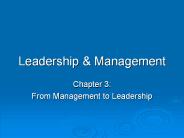WHAT IS LEADERSHIP? - PowerPoint PPT Presentation
1 / 13
Title:
WHAT IS LEADERSHIP?
Description:
Studies attempted to define leader traits. 10 Traits of leaders(Stodgill survey) ... Four types of Group Leadership Functions (Hackman & Walton, 1986) ... – PowerPoint PPT presentation
Number of Views:1317
Avg rating:3.0/5.0
Title: WHAT IS LEADERSHIP?
1
WHAT IS LEADERSHIP?
- Major Resource Peter G. Northhouse, Leadership
Theory and Practice, (Thousand Oaks Sage
Publications, 1997).
2
Trait Theories (Great Man Theories)
- Focuses solely on leaders.
- Studies attempted to define leader traits.
3
10 Traits of leaders(Stodgill survey)
- 1. Willing to take responsibility and complete
tasks. - 2. Pursues goals.
- 3. Likes problem solving.
- 4. Exercises initiative in social situations.
- 5. Self-confident.
4
10 Traits of leaders(Stodgill survey contd.)
- 6. Willing to accept consequences.
- 7. Ready to absorb interpersonal stress.
- 8. Willing to tolerate frustration and delay.
- 9. Able to influence behavior of others.
- 10. Able to structure social interactions for
group purposes (Northhouse, 15).
5
Style Theories
- Emphasize the behavior of the leader, focusing on
how they act and what they do. - Leadership includes two types of behaviors task
behaviors and relationship behaviors. - Task behaviors help group members to achieve
their objectives. - Relationship behaviors make group members feel
comfortable and secure in their group environment.
6
Situational Theories
- Focus on leadership in situations different
situations need different kinds of leadership. - Leaders direct and support.
- Group competence and commitment determines
necessary skill mix.
7
Contingency Theories
- Right leaders style needs to be matched to the
right setting. - Two major styles Task motivated and
relationship motivated. - Three situation variables
- Leader-member relations
- Task structure
- Position power
8
Path-Goal Theories
- Emphasize ability of leader to motivate followers
to succeed. - Leaders define the goal, clarify path to goal
attainment, remove obstacles to goal attainment,
and provide support. - Leaders increase the amount and kinds of payoffs
followers receive from their work.
9
Leader-Member Exchange Theories
- Leadership is an interactive process between
leaders and followers. - Exchange develops through three stages
- Stranger phase is structured, low trust, goal
focused. - Acquaintance phase involves tests of trust, new
goal and relationship orientation. - Mature partnership phase has negotiated levels of
responsibility, higher trust and obligation
levels.
10
Transformational Leadership
- Leadership is a process that changes and
transforms leaders and followers, particularly
their values and ethics. - James MacGregor Burns is key advocate.
11
Transformational Leadership (contd.)
- Two types of leadership
- Transactional leadership followers do will of
leader in order to have specific needs satisfied. - Transformational leadership followers motivated
by transformed morality.
12
Team Leadership Theories
- Teams share goals, coordinate activities.
- Four types of Group Leadership Functions (Hackman
Walton, 1986) - Diagnose group problems (monitoring/internal)
- Correct problems (corrective acting/internal)
- Forecast environmental change (monitoring/external
) - Take advantage of changes (acting/external)
13
Psychodynamic Theories
- Key Psychological themes
- Family of Origin determines personality.
- Maturation from child to adult affects traits,
behaviors. - Dependent, rebellious, or independent responses
to leadership - Relationship development and maturation in family
influences leader/follower ability.































